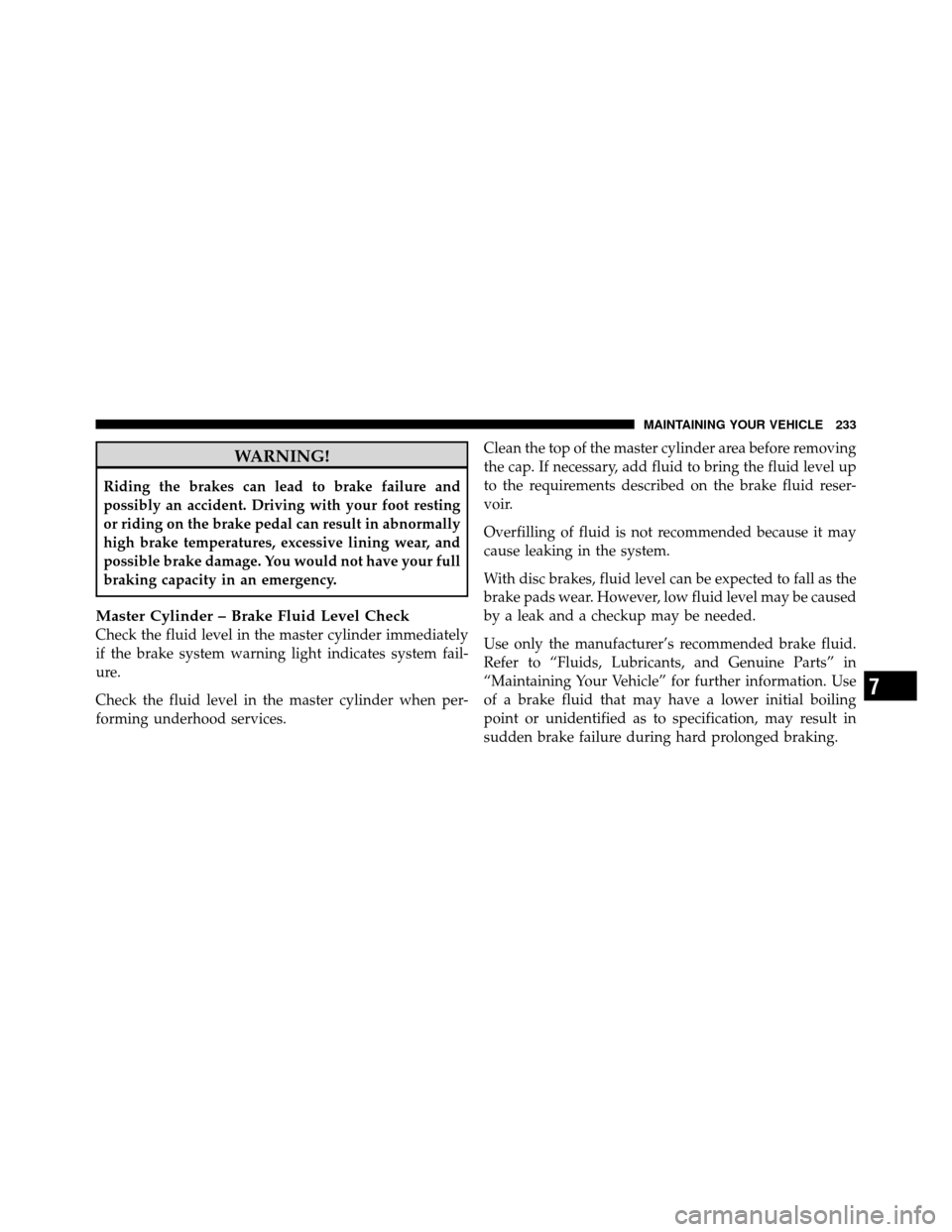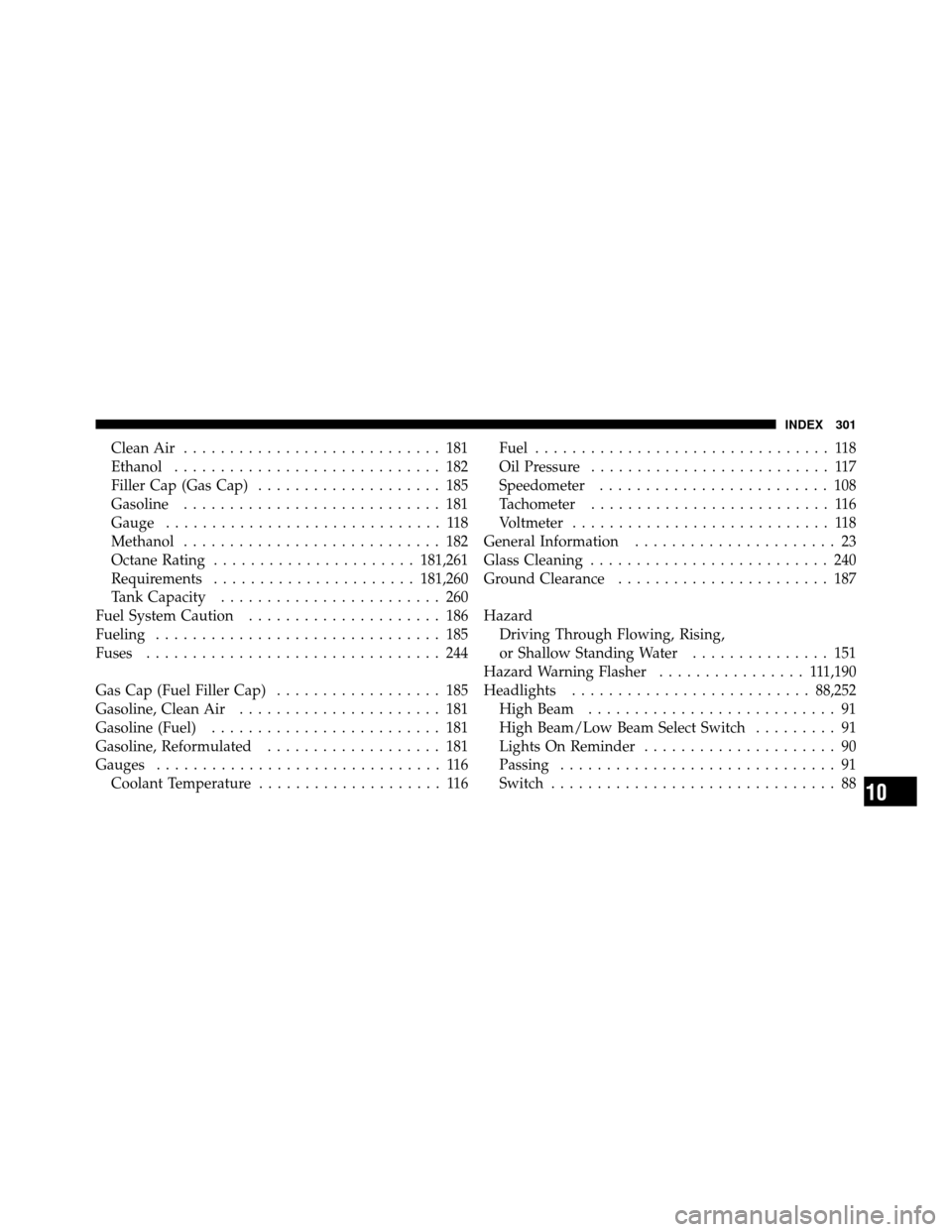Page 67 of 315

BREAK-IN RECOMMENDATIONS
A long break-in period is not required for the drivetrain
(engine, transmission, and rear axle) in your new vehicle.
Following these few simple guidelines is all that is
necessary for a good break-in.
For the first 500 miles (800 km):
•Keep your vehicle speed below the legal, posted speed
limit and your engine speed below 4,000 RPM.
•Avoid driving at a constant speed, either fast or slow,
for long periods.
•Do not make any full throttle starts and avoid full
throttle acceleration.
•Use the proper gear for your speed range.
•Wait until the engine has reached normal operating
temperature before driving at the recommended maxi-
mum break-in speed.
•Avoid excessive idling.
•Check the engine oil level at every fuel fill.
NOTE: A new engine will consume some oil during the
first few thousand miles (kilometers) of operation. This
should be considered a normal part of the break-in and
not interpreted as a sign of difficulty.
2
THINGS TO KNOW BEFORE STARTING YOUR VEHICLE 63
Page 111 of 315
INSTRUMENT PANEL FEATURES
1 — Air Outlet7 — Speedometer/Odometer 13 — Climate Control
2 — Sound System Speaker 8 — Oil Pressure Gauge 14 — ENGINE START Button
3 — Main Message Center 9 — Passenger Airbag Off Light 15 — Voltage Gauge
4 — Fuel Gauge 10 — Passenger Airbag 16 — Engine Coolant Temperature Gauge
5 — Auxiliary Message Center 11 — Glove Compartment 17 — Engine Oil Temperature Gauge
6 — Tachometer 12 — Sound System Controls 18 — TRIP Button
4
UNDERSTANDING YOUR INSTRUMENT PANEL 107
Page 121 of 315

Oil Temperature Gauge
This gauge shows the oil temperature. The
gauge pointer will likely show higher tempera-
tures when driving in hot weather, up moun-
tain grades, or in heavy stop and go traffic. If
the red Warning Light remains on after the bulb check or
turns on while driving, safely bring the vehicle to a
complete stop and turn off the engine. DO NOT operate
the vehicle until the cause is corrected.
Oil Pressure Gauge
This gauge shows engine oil pressure when the
engine is running. The pressure will vary with
engine speed, oil viscosity, and engine tem-
perature. Oil pressures will be higher as the
engine is warming up. The normal operating pressure is
between 20 and 80 psi (pounds per square inch). If the
pointer remains in the red range, safely bring the vehicle
to a complete stop and turn off the engine. DO NOT
operate the vehicle until the cause is corrected. This gauge does not indicate the amount of oil in the
engine. The engine oil level must be checked under the
hood. Check the level often during severe usage.
Oil Pressure Warning Light
The red Oil Pressure Warning Light is located in
the Oil Pressure Gauge. It will turn on to indicate
low engine oil pressure. The light should turn on briefly
as a bulb check when the engine is first started. If the
light remains on or turns on while driving, safely bring
the vehicle to a complete stop and turn off the engine. DO
NOT operate the vehicle until the cause is corrected.
NOTE: This light does not indicate how much oil is in
the engine. The engine oil level must be checked using
the procedure shown in “Maintaining Your Vehicle”.
4
UNDERSTANDING YOUR INSTRUMENT PANEL 117
Page 218 of 315

Engine Oil
Checking Oil Level
To assure proper engine lubrication, the engine oil must
be maintained at the correct level. Check the oil level at
regular intervals, such as every fuel stop. The best time to
check the oil level is approximately five minutes after a
fully warmed engine is turned off or before starting the
engine after it has sat overnight.
Checking the oil while the vehicle is on level ground also
will improve the accuracy of the oil level readings. Add
oil only when the level is below the SAFE mark.
CAUTION!
Overfilling or underfilling will cause oil aeration or
loss of oil pressure. This could damage your engine.
Change Engine Oil
Road conditions and your kind of driving affect the
interval at which your oil should be changed. Check the
following list to see if any apply to you.
•Day or night temperatures are below 32°F (0°C)
•Stop and go driving
•Extensive engine idling
•Driving in dusty conditions
•Short trip driving of less than 10 miles (16.2 km)
•More than 50% of your driving is at sustained high
speeds during hot weather, above 90°F (32°C)
NOTE: IfANY of these apply to you, then change your
engine oil every 3,000 miles (5 000 km) or three months,
whichever comes first, and follow “Maintenance Sched-
ule B.” Refer to “Maintenance Schedule” for further
information.
214 MAINTAINING YOUR VEHICLE
Page 219 of 315

If none of these apply to you, then change your engine oil
at every interval shown on “Maintenance Schedule A.�
Refer to “Maintenance Schedule” for further information.
NOTE: Under no circumstances should oil change in-
tervals exceed 6,000 miles (10 000 km) or six months,
whichever comes first.
Engine Oil Selection
For best performance and maximum protection under all
types of operating conditions, the manufacturer only
recommends full synthetic engine oils that meet the
requirements of Chrysler Material Standard MS-10725
and are approved to MB 229.3 or MB 229.5.
The manufacturer recommends the use of a full synthetic
5W-40 or equivalent engine oil.
CAUTION!
Do not use chemical flushes in your engine oil as the
chemicals can damage your engine. Such damage is
not covered by the New Vehicle Limited Warranty.
Engine Oil Viscosity (SAE Grade)
SAE 5W-40 engine oil is preferred for use in all operating
temperatures.
The engine oil filler cap also shows the recommended engine
oil viscosity for your engine. For information on engine oil
filler cap location, refer to “Engine Compartment” in “Main-
taining Your Vehicle” for further information.
Synthetic Engine Oils
You may use synthetic engine oils provided the recom-
mended oil quality requirements are met, and the recom-
mended maintenance intervals for oil and filter changes
are followed.
7
MAINTAINING YOUR VEHICLE 215
Page 237 of 315

WARNING!
Riding the brakes can lead to brake failure and
possibly an accident. Driving with your foot resting
or riding on the brake pedal can result in abnormally
high brake temperatures, excessive lining wear, and
possible brake damage. You would not have your full
braking capacity in an emergency.
Master Cylinder – Brake Fluid Level Check
Check the fluid level in the master cylinder immediately
if the brake system warning light indicates system fail-
ure.
Check the fluid level in the master cylinder when per-
forming underhood services.Clean the top of the master cylinder area before removing
the cap. If necessary, add fluid to bring the fluid level up
to the requirements described on the brake fluid reser-
voir.
Overfilling of fluid is not recommended because it may
cause leaking in the system.
With disc brakes, fluid level can be expected to fall as the
brake pads wear. However, low fluid level may be caused
by a leak and a checkup may be needed.
Use only the manufacturer’s recommended brake fluid.
Refer to “Fluids, Lubricants, and Genuine Parts” in
“Maintaining Your Vehicle” for further information. Use
of a brake fluid that may have a lower initial boiling
point or unidentified as to specification, may result in
sudden brake failure during hard prolonged braking.
7
MAINTAINING YOUR VEHICLE 233
Page 271 of 315
MAINTENANCE SCHEDULE B
Follow “Maintenance Schedule B” if you usually operate
your vehicle under one or more of the following condi-
tions.
•Day or night temperatures are below 32°F (0°C).
•Stop and go driving.
•Extensive engine idling.
•Driving in dusty conditions.
•Short trips of less than 10 miles (16 km).
•More than 50% of your driving is at sustained high
speeds during hot weather, above 90°F (32°C).NOTE:
•If
ANY of these apply to you, then change your engine
oil every 3,000 miles (5000 km) or three months,
whichever comes first, and follow the maintenance
recommendations in “Maintenance Schedule “B” in
this section.
•If ANY of these apply to you, then flush and replace
the engine coolant every 102,000 miles (170 000 km) or
60 months, whichever comes first, and follow the
maintenance recommendations in “Maintenance
Schedule B” in this section.
8
M A I
N T
E
N A
N CE
S
C
H E
D
U L
E
SMAINTENANCE SCHEDULES 267
Page 305 of 315

Clean Air............................ 181
Ethanol ............................. 182
Filler Cap (Gas Cap) .................... 185
Gasoline ............................ 181
Gauge .............................. 118
Methanol ............................ 182
Octane Rating ...................... 181,261
Requirements ...................... 181,260
Tank Capacity ........................ 260
Fuel System Caution ..................... 186
Fueling ............................... 185
Fuses ................................ 244
Gas Cap (Fuel Filler Cap) .................. 185
Gasoline, Clean Air ...................... 181
Gasoline (Fuel) ......................... 181
Gasoline, Reformulated ................... 181
Gauges ............................... 116
Coolant Temperature .................... 116 Fuel
................................ 118
Oil Pressure .......................... 117
Speedometer ......................... 108
Tachometer .......................... 116
Voltmeter ............................ 118
General Information ...................... 23
Glass Cleaning .......................... 240
Ground Clearance ....................... 187
Hazard Driving Through Flowing, Rising,
or Shallow Standing Water ............... 151
Hazard Warning Flasher ................ 111,190
Headlights .......................... 88,252
High Beam ........................... 91
High Beam/Low Beam Select Switch ......... 91
Lights On Reminder ..................... 90
Passing .............................. 91
Switch ............................... 88
10
INDEX 301